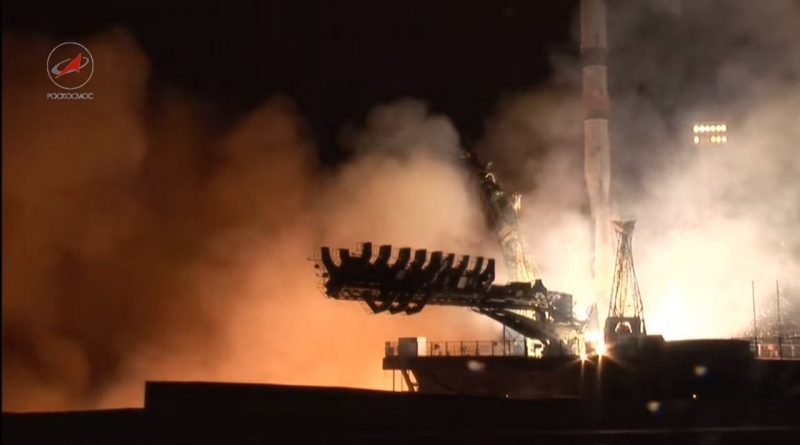Fresh Cargo en-route to Space Station after flawless Soyuz U Launch with Progress MS-03
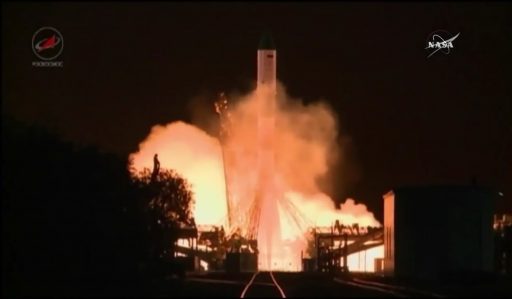
Russia’s Soyuz rocket made a pre-dawn liftoff from the Baikonur Cosmodrome Sunday morning, flying toward the sunrise to deliver the Progress MS-03 cargo spacecraft to orbit for a resupply flight to the Space Station.
Progress MS-03 is the second of three planned Progress missions this year, primarily dedicated to resupply of the Russian Segment of ISS but also delivering important commodities such as fuel for the Station’s engines. The mission comes in a busy period for ISS with Soyuz MS-01 having just arrived with three crew members last week and the next SpaceX Dragon ready for an early Monday liftoff.
Progress MS-03 is the 155th Progress mission in a program dating back to 1978. Over its four-decade career, Progress visited Russia’s Salyut and Mir space stations and, to date, performed 66 missions in support of the International Space Station Program (including MS-03). It is the third flight of the new Progress MS line of spacecraft featuring a number of improvements primarily focused on the Navigation, Control and Communications system of the spacecraft.
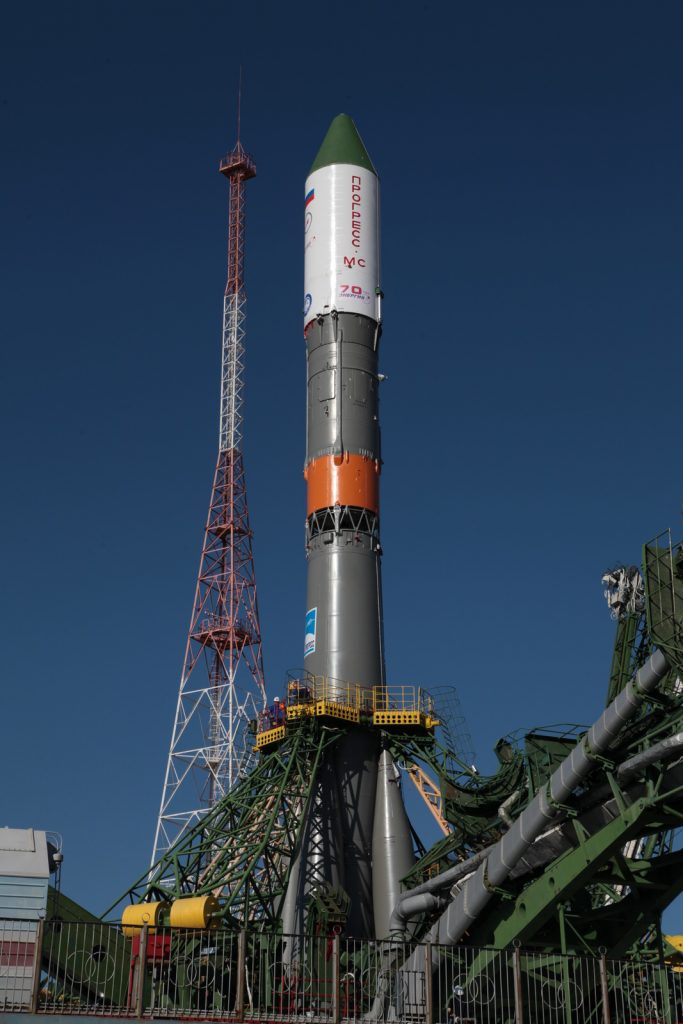
Loaded with 2,400 Kilograms of food, fuel and supplies, Progress MS-03 utilized the third-to-last Soyuz U rocket for its launch into orbit. Looking back at a 43-year career, Soyuz U is the longest serving rocket in spaceflight history with over 780 missions, setting the gold-standard for flight heritage and reliability at a success rate of over 97%.
Soyuz U is being discontinued in favor of the modern Soyuz 2 version, also due to the fact that the launcher’s older analog Flight Control System requires parts to be imported from the Ukraine.
As per the current plan, Progress MS-4 will lift off atop a Soyuz U later this year to be followed by the final launch of the Soyuz U in February 2017 with the Progress MS-05 spacecraft.
Fitted atop its 46-meter tall Launch Vehicle, Progress MS was moved to the launch pad under clear skies Friday morning. Once raised to its vertical position, Soyuz U was connected to the various umbilicals to deliver propellant, electrical power and data connectivity to the launcher.
A final series of tests confirmed readiness of the launcher and spacecraft, allowing the Russian State Commission to provide clearance for propellant loading that picked up Saturday night with four hours to go until liftoff. The two-hour propellant loading activity was by the book as 12 tanks aboard the boosters, core stage and Block I third stage were filled with 274 metric tons of refined Kerosene and Liquid Oxygen.
The boosters and core stage also received Liquid Nitrogen to act as tank pressurization gas and Hydrogen Peroxide to power the turbopumps of the RD-117 and 118 engines during flight.
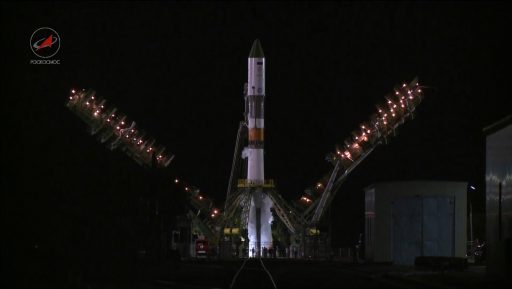
With countdown milestones being checked off as planned, the venting Soyuz U was revealed just over half an hour prior to liftoff when the two halves of the Service Structure were lowered. Teams then departed the launch pad, either to a safe distance or to the Launch Bunker from where the countdown and flight was controlled.
Progress switched to autonomous power 14 minutes prior to launch, also transitioning its flight control system to launch mode to be ready for the nine-minute ride into orbit. The Guidance System of the Soyuz was enabled ten minutes before launch and a last check by all stations confirmed ‘ten-minute launch readiness.’
Heading into the last six minutes, Soyuz began executing a highly choreographed sequence to transition to its autonomous launch configuration. Soyuz purged its booster and core stage engines with nitrogen to remove any combustible substances and ensure a controlled ignition, next was the pressurization of propellant tanks followed by the handover of control to the Soyuz that also switched to internal power at the T-1-minute mark.
Ignition Sequence Start was commanded at T-20 seconds and igniters were fired as turbopumps spun to flight speed and propellants were injected into the engines to initiate the combustion process. All engines reached a preliminary thrust setting before ramping up to a collective liftoff thrust of 420 metric tons, overcoming counterweights to lift the 313-metric-ton Soyuz rocket off the ground.
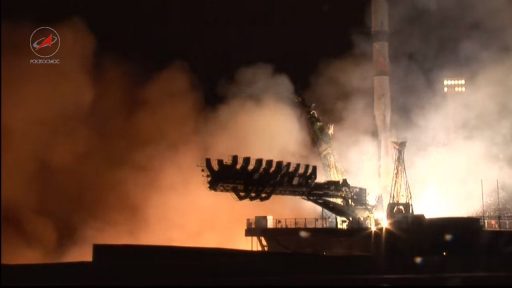
Soyuz started rising a precisely 21:41:45.237 UTC on Saturday, thundering off on a nine-minute climb into orbit. Lighting up the Kazakh launch site, Soyuz balanced in a vertical posture for the first ten seconds of the flight before pitching over to depart Baikonur to the north-east along the standard route to ISS.
Burning 1,600 Kilograms of Kerosene and supercold Liquid Oxygen each second of powered flight, Soyuz quickly passed Mach 1 and pushed through the area of Maximum Dynamic Pressure around one minute into the flight. Calls from the Launch Bunker indicated rock solid performance of the four liquid-fueled boosters, tasked with helping Soyuz accelerate to a speed of 1.5 Kilometers per second.
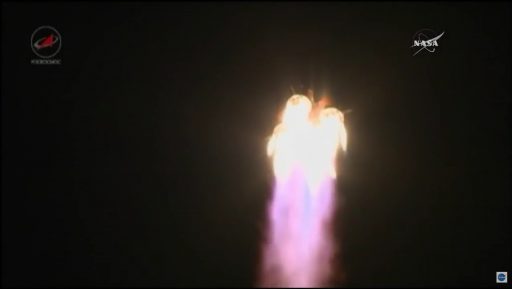
The four boosters, each burning through 39,600kg of propellant, shut down their engines one minute and 58 seconds after launch and separated via pyrotechnics and pushers, swinging out and away from the still-firing core stage. With the boosters heading for a crash landing 348 Kilometers from the launch site, Soyuz continued its ride uphill under the power of the core stage alone, generating a vacuum thrust of just over 100 metric ton-force.
Assisted by four gimbaling verniers, the Core Stage showed nominal stabilization throughout its operation, continuing its trek toward the Russian-Kazakh border. Two minutes and 41 seconds into the flight when Soyuz was 85 Kilometers in altitude, the protective shroud split open and separated from the Soyuz to shed no-longer-needed weight as the spacecraft could no longer be harmed by aerodynamic forces.
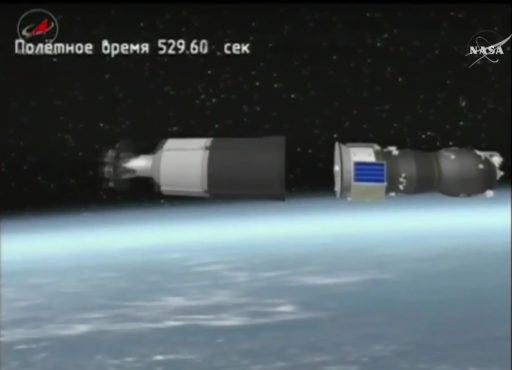
Shutdown of the RD-118 engine occurred four minutes and 45 seconds into the flight followed two seconds later by the hot staging sequence in which the RD-0110 engine on the Block I third stage was commanded to fire split seconds before separation pyros were initiated so that the 3rd stage could pull away from the spent core – headed for re-entry and impact 1,550 Kilometers from Baikonur.
Tasked with increasing the stack’s speed by 4 Kilometers per second, the third stage was set for a three-minute and 58-second burn of its RD-0110 engine, delivering 30,400kgf of thrust. Separating its aft covers ten seconds after ignition, the third stage continued to head down its prescribed trajectory with good call-outs heard from the Launch Bunker throughout its burn.
Progress MS-03 was aiming for the standard injection orbit of 193 by 245 Kilometers inclined 51.65 degrees.
Soyuz U shut down its third stage 8 minutes and 46 seconds after liftoff followed three seconds later by the separation of the 7,290-Kilogram cargo ship.
Immediately after being released, Progress MS-03 went through time-tagged commands to deploy the two power-generating solar arrays and the forward-facing KURS navigational antennas to come into play during the craft’s rendezvous. The Unified Propulsion System was pressurized and Progress primed its thrusters to null out residual body rates and enter a sun-pointed orientation during its first lap around the planet.
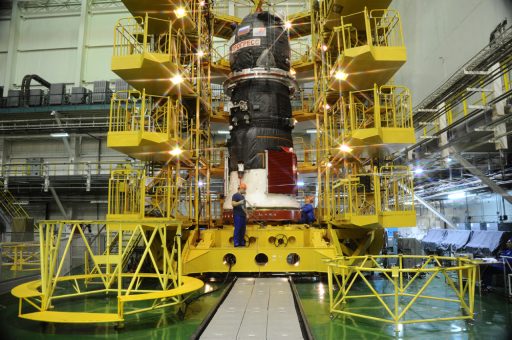
Sticking to the 34-orbit rendezvous, Progress MS-03 will be tasked with a pair of engine burns on its third orbit followed by a burn late on Sunday on Orbit 18 to set the spacecraft on its course to ISS, catching up from behind and below.
Over the course of its two-day free flight, Progress will continue testing of the newly introduced MS systems modifications that premiered last December and also helped successfully fly last week’s Soyuz mission to the ISS. The MS upgrade focuses on communications and navigation systems, inaugurating a new Unified Command & Telemetry System replacing the Ukrainian-built Kvant-V radio. GPS and Glonass receivers allow Soyuz and Progress to complete on-board orbit determination and the new KURS-NA radio navigation system reduces the number of antennas on the spacecraft.
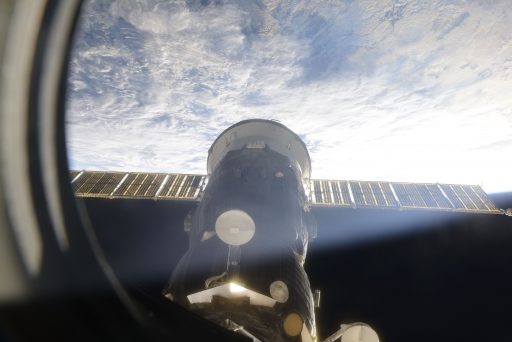
A Phased Array Antenna installed on the spacecraft allows Progress MS to communicate with Luch 5 data relay satellites in Geostationary Orbit for a continuous link to Mission Control. Also, relative navigation with ISS will be possible through the exchange of GPS/Glonass data, adding flexibility and redundancy to the missions. Other changes on the spacecraft include the addition of external debris shields, the implementation of a backup drive mechanism in the docking mechanism and the inauguration of external compartments that can be used to release small CubeSats into orbit.
The Automated Rendezvous will be initiated on Monday and comprises a series of maneuvers to guide the Progress to a fully automated docking to the Pirs module set for 0:22 UTC on Tuesday.

